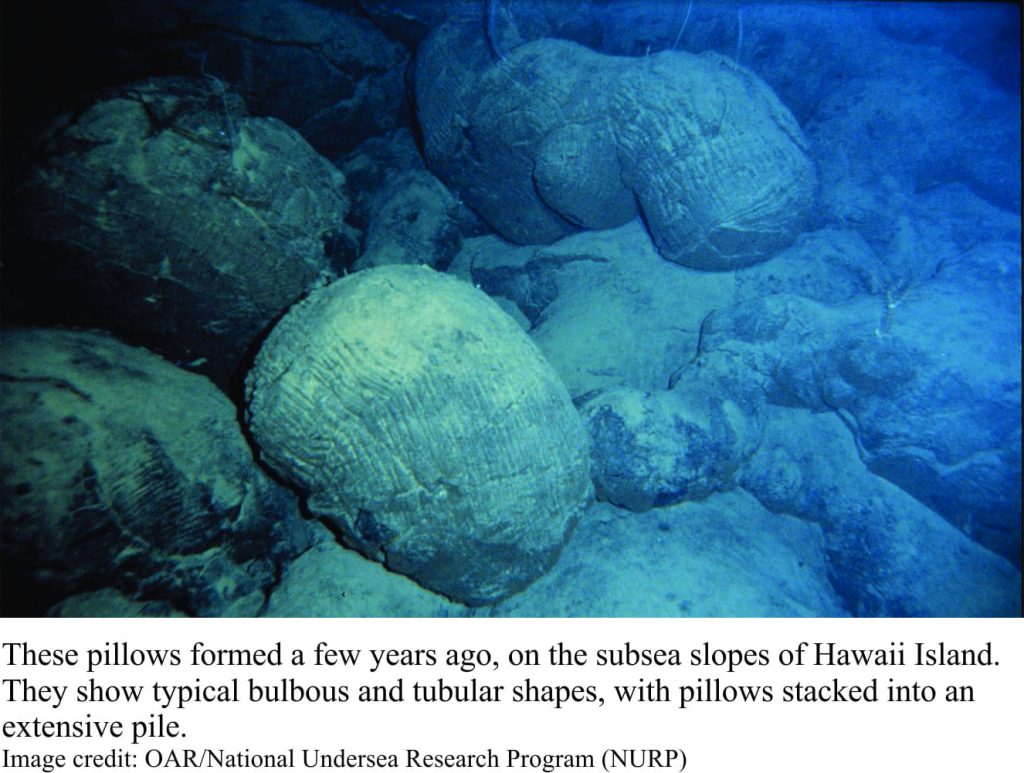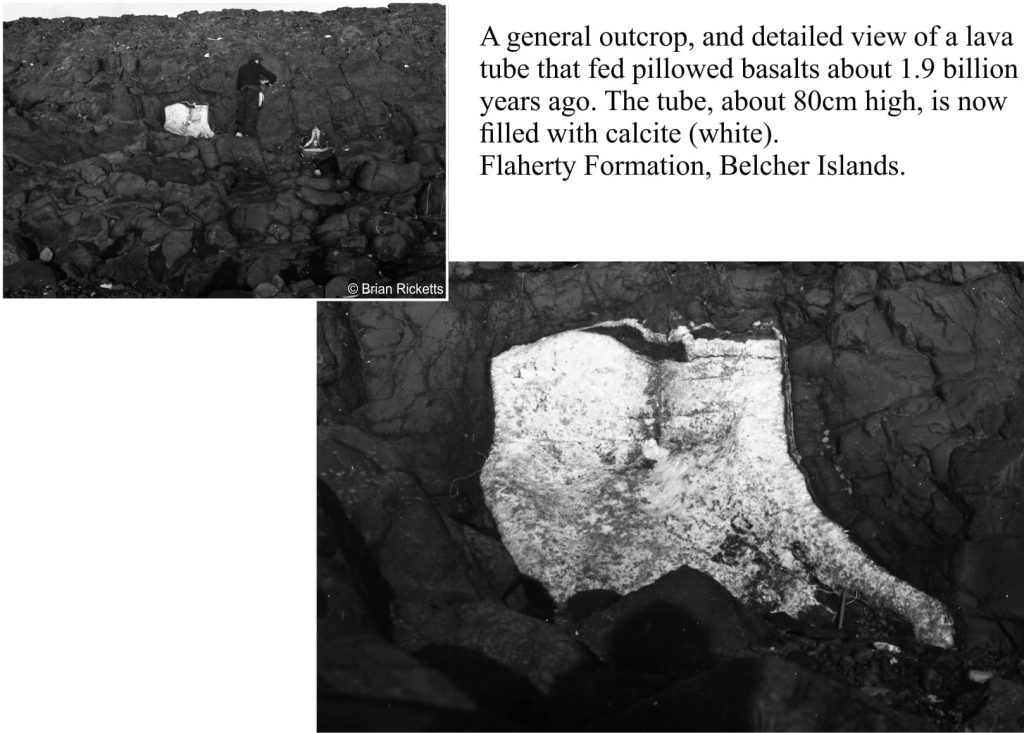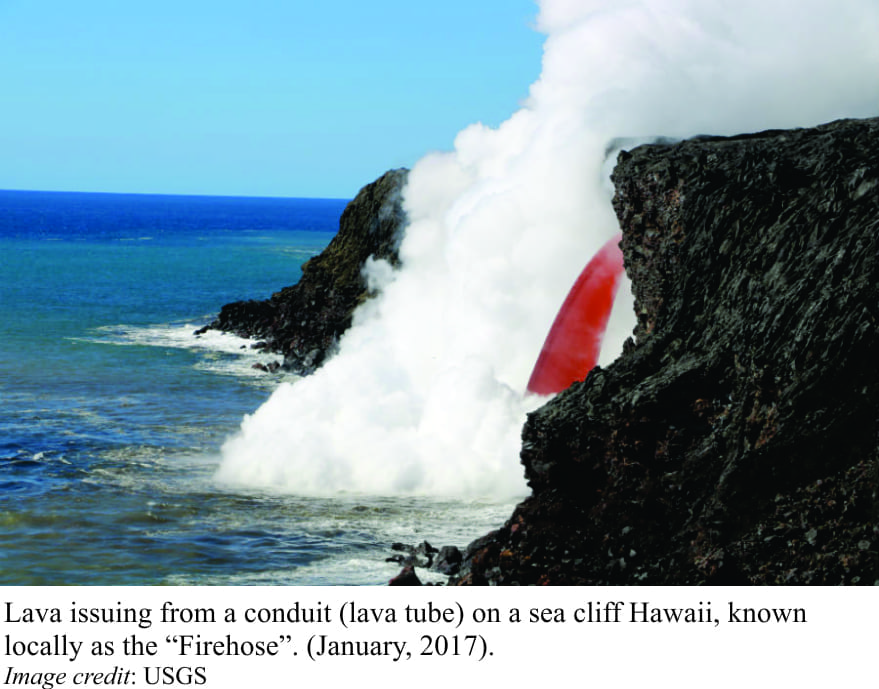 Analogies are the stuff of science. In geology, we frequently employ modern analogies of physical, chemical, or biological processes to help us interpret events that took place in the distant past. We cannot observe directly geological events beyond our own collective memory. Instead, we must infer what might have taken place based on evidence that is recorded in rocks, fossils, chemical compounds, and the various signals that the earth transmits (such as acoustic or electrical signals). Analogies are not exact replicas of things or events, although they may come quite close. Their primary function is to guide us in our attempts to interpret the past. As such, they are part of our rational discourse with deep time. Analogies are at the heart of the concept of Uniformity espoused by our 18th and 19th century geological heroes, James Hutton and Charles Lyell; they are the foundation for the common dictum “the present is the key to the past”, coined by Archibald Geikie, an early 20th century Scottish geologist.
Analogies are the stuff of science. In geology, we frequently employ modern analogies of physical, chemical, or biological processes to help us interpret events that took place in the distant past. We cannot observe directly geological events beyond our own collective memory. Instead, we must infer what might have taken place based on evidence that is recorded in rocks, fossils, chemical compounds, and the various signals that the earth transmits (such as acoustic or electrical signals). Analogies are not exact replicas of things or events, although they may come quite close. Their primary function is to guide us in our attempts to interpret the past. As such, they are part of our rational discourse with deep time. Analogies are at the heart of the concept of Uniformity espoused by our 18th and 19th century geological heroes, James Hutton and Charles Lyell; they are the foundation for the common dictum “the present is the key to the past”, coined by Archibald Geikie, an early 20th century Scottish geologist.
Even though lots of people have written about this, I figure one more example that illustrates the methodology won’t hurt. Forty years ago, I worked on some very old rocks on Belcher Islands, Hudson Bay, that included volcanic deposits. Looking at the photos (35mm slides), I still marvel at the geology, the fact that something almost 2 billion years old is so well preserved, makes it look like the volcano just erupted.
Here are three ancient structures that were constructed by flowing basalt lava. Each can be compared with modern volcanic structures and processes that we can observe directly. We can interpret the ancient structures according to the similarities and differences between the modern analogues and the ancient versions. The examples are from strata known as the Flaherty Formation, a succession of volcanic rocks exposed on Belcher Islands, Hudson Bay.
Ropy lava: Slow-moving (pahoehoe) lava flows begin almost immediately to cool from the top down. As the crust develops, it forms curved, sinuous, and twisted ribs, initially near the front of the flow, gradually extending back up the flow. There is a resemblance to braided rope, hence the name. Crusty ribs become twisted and arcuate because flowing lava beneath the crust acts as a drag. This video link shows this process very nicely.
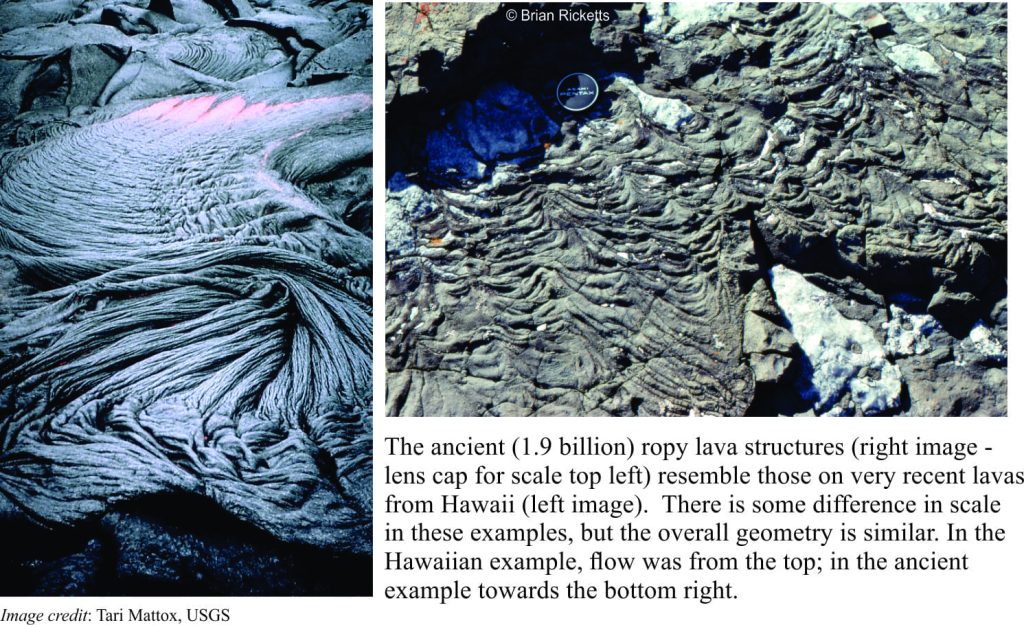 In the recent example from Hawaii, the flow top is festooned with ropy crusts of different shapes and sizes; note too that we can usually observe these recent flows in their entirety. However, exposure of ancient flows (or any other strata for that matter) is limited by the vagaries of erosion, vegetation cover, and whether the rocks are exposed in a cliff face or along flatter ground. The ancient example shown here is of more limited exposure than the Hawaiian view, but it contains enough information that allows us to make a favourable comparison with the modern analogue.
In the recent example from Hawaii, the flow top is festooned with ropy crusts of different shapes and sizes; note too that we can usually observe these recent flows in their entirety. However, exposure of ancient flows (or any other strata for that matter) is limited by the vagaries of erosion, vegetation cover, and whether the rocks are exposed in a cliff face or along flatter ground. The ancient example shown here is of more limited exposure than the Hawaiian view, but it contains enough information that allows us to make a favourable comparison with the modern analogue.
Pillow lavas: Lava extruded under water (seas, lakes) commonly forms bulbous masses called, fittingly, pillow lavas. Flowing lava cools very rapidly in water, forming a crust that expands as the molten rock continues to flow. Eventually the crust is breached, and the process begins anew. In this way flowing lava can form great piles of spherical, to tubular globules. Some pillows break off the pile and tumble down-slope, but many are interconnected. The process of pillow formation is nicely illustrated in this example from Hawaii.
Pillowed basaltic lavas are most common in oceanic crust, where they are produced at mid-ocean spreading ridges, and at volcanic hot-spots like Hawaii, Canary Islands, and other oceanic islands.
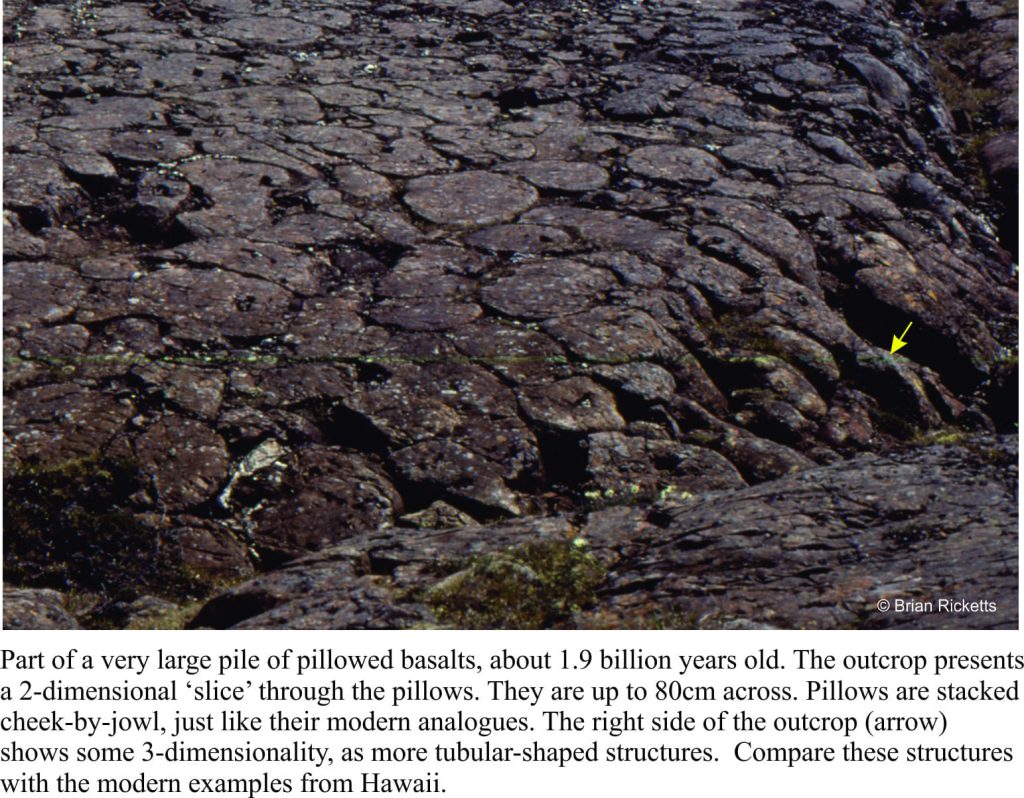 Pillowed lavas are also very common constituents of volcanism in the geological record. The more expansive image (above) shows an erosional slice through a large pile of pillowed basalts. Our view of these structures is 2-dimensional over most of the outcrop, but we can see that the pillow shapes are quite variable. However, at the edge of the outcrop, we are gifted a 3-dimensional view that shows nice tubular and oval-shaped, interconnected masses, looking very much like those modern analogues observed in Hawaii.
Pillowed lavas are also very common constituents of volcanism in the geological record. The more expansive image (above) shows an erosional slice through a large pile of pillowed basalts. Our view of these structures is 2-dimensional over most of the outcrop, but we can see that the pillow shapes are quite variable. However, at the edge of the outcrop, we are gifted a 3-dimensional view that shows nice tubular and oval-shaped, interconnected masses, looking very much like those modern analogues observed in Hawaii.
The close-up view (below) shows details that help add more clarity to our interpretation. Pillow margins, like rinds, have a different colour and, although not visible in these views, the minerals tend to be much smaller than the pillow interior; the margins are also glassy. These attributes, that we can witness in modern analogues, develop during rapid chilling of the original lava; they are referred to as chilled margins, or selvages.
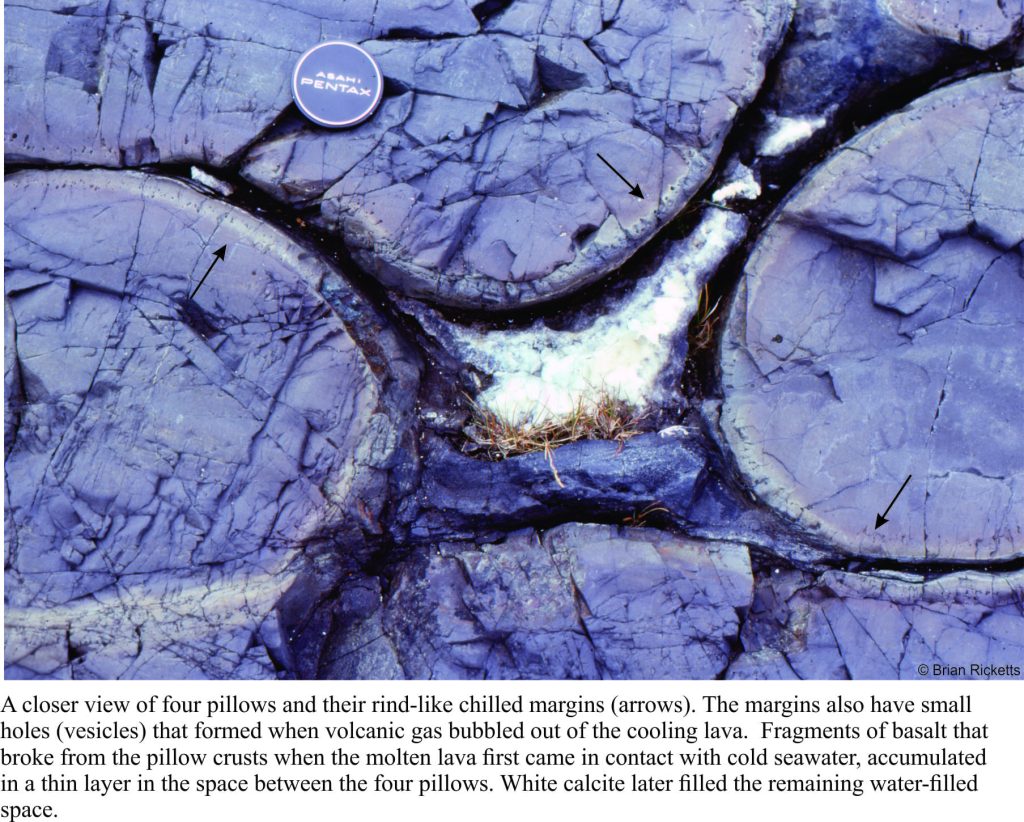 Rapid chilling, or thermal shock of lava in water also produces small fragments of basalt. These will filter through the crevasses between pillows, eventually settling on top of other pillows or on the sea floor. In the ancient example here, basalt fragments formed a thin layer of sediment in the space between four pillows. The remaining gap would have originally been filled with seawater, but as the rocks were gradually buried, this space too was filled with large crystals of calcite.
Rapid chilling, or thermal shock of lava in water also produces small fragments of basalt. These will filter through the crevasses between pillows, eventually settling on top of other pillows or on the sea floor. In the ancient example here, basalt fragments formed a thin layer of sediment in the space between four pillows. The remaining gap would have originally been filled with seawater, but as the rocks were gradually buried, this space too was filled with large crystals of calcite.
Lava tubes: During an eruption, the most obvious exuded magma flows over the volcano surface. However, flow can also occur through conduits, or tubes beneath the surface; the tubes can be several metres wide, and 10s to 100s of metres long. Some of the recent (2017) lava flows on the coast of Hawaii Island have been fed by lava tubes (see image at top of page). When an eruption ceases, lava in the tube may solidify, or the lava may drain from the tube leaving an open conduit, or the tube may collapse.
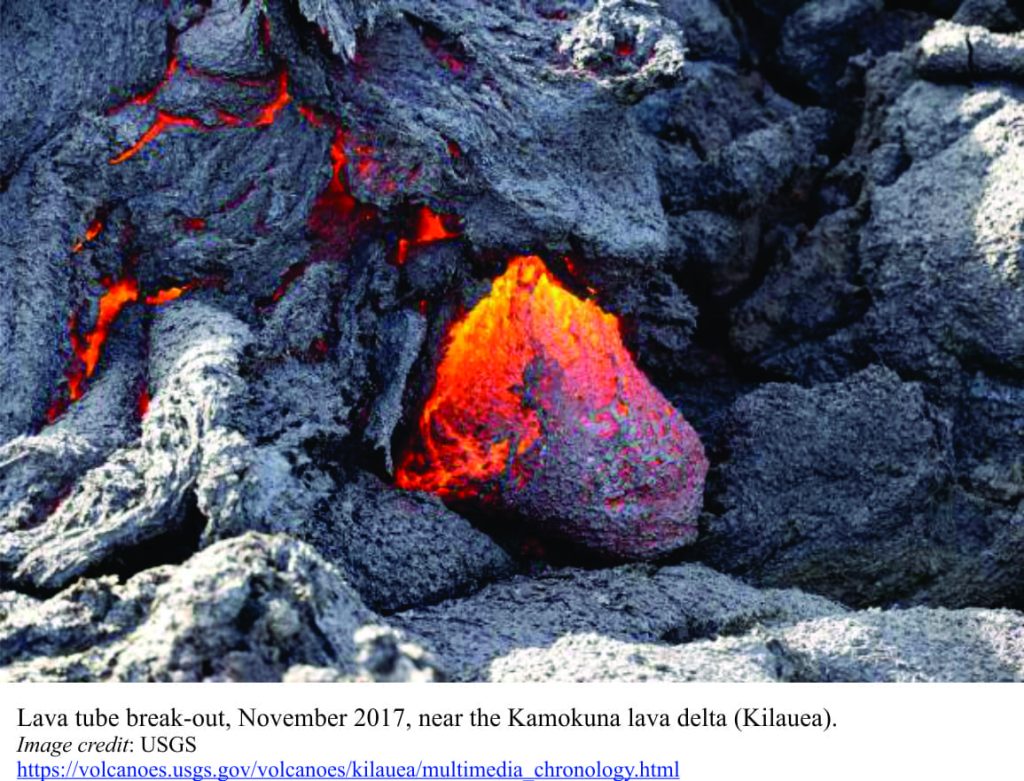 Tubes can also feed pillow lavas, and an example is shown here. The ancient lava in this tube partly drained away – either the eruption had ceased, or the tube was blocked farther upstream. Part of the tube remained open to seawater, and eventually was filled, like the space between the pillows themselves, with calcite (and another mineral called prehnite). Filling with calcite prevented the total collapse of the tube as the volcanic rocks were gradually buried beneath other strata.
Tubes can also feed pillow lavas, and an example is shown here. The ancient lava in this tube partly drained away – either the eruption had ceased, or the tube was blocked farther upstream. Part of the tube remained open to seawater, and eventually was filled, like the space between the pillows themselves, with calcite (and another mineral called prehnite). Filling with calcite prevented the total collapse of the tube as the volcanic rocks were gradually buried beneath other strata.
Afterword: Although geologists have formalized the use of analogy (al la Archibald Geikie) as a tool to further our understanding of the world (universe), it has been an important part of the science armoury for centuries. Leonardo da Vinci used the analogy of modern seashells to explain the fossil equivalents recovered from mountain tops. Seriously famous icons like James Hutton, Charles Lyell, and Charles Darwin, all used analogy to help explain geological phenomena, long before Geikie’s pronouncement. Perhaps analogy is also an expression of common sense. Either way, we’d be lost without it.
About 100 images of modern and ancient volcanic-volcaniclastic rocks are included in the Atlas of sediments and sedimentary structures: Volcanoes and the products of volcanic eruptions
